
Cubism is an early-20th-century avant-garde art movement that revolutionized European painting and sculpture, and inspired related movements in music, literature and architecture. In Cubist artwork, objects are analyzed, broken up and reassembled in an abstracted form—instead of depicting objects from a single viewpoint, the artist depicts the subject from a multitude of viewpoints to represent the subject in a greater context. Cubism has been considered the most influential art movement of the 20th century. The term is broadly used in association with a wide variety of art produced in Paris or near Paris (Puteaux) during the 1910s and throughout the 1920s.

Jean Dominique Antony Metzinger was a major 20th-century French painter, theorist, writer, critic and poet, who along with Albert Gleizes wrote the first theoretical work on Cubism. His earliest works, from 1900 to 1904, were influenced by the neo-Impressionism of Georges Seurat and Henri-Edmond Cross. Between 1904 and 1907 Metzinger worked in the Divisionist and Fauvist styles with a strong Cézannian component, leading to some of the first proto-Cubist works.

The Salon d'Automne, or Société du Salon d'automne, is an art exhibition held annually in Paris, France. Since 2011, it is held on the Champs-Élysées, between the Grand Palais and the Petit Palais, in mid-October. The first Salon d'Automne was created in 1903 by Frantz Jourdain, with Hector Guimard, George Desvallières, Eugène Carrière, Félix Vallotton, Édouard Vuillard, Eugène Chigot and Maison Jansen.

Albert Gleizes was a major 20th-century French artist, theoretician, philosopher, a self-proclaimed founder of Cubism and an influence on the School of Paris. Albert Gleizes and Jean Metzinger wrote the first major treatise on Cubism, Du "Cubisme", 1912. Gleizes was a founding member of the Section d'Or group of artists. He was also a member of Der Sturm, and his many theoretical writings were originally most appreciated in Germany, where especially at the Bauhaus his ideas were given thoughtful consideration. Gleizes spent four crucial years in New York, and played an important role in making America aware of modern art. He was a member of the Society of Independent Artists, founder of the Ernest-Renan Association, and both a founder and participant in the Abbaye de Créteil. Gleizes exhibited regularly at Léonce Rosenberg's Galerie de l’Effort Moderne in Paris; he was also a founder, organizer and director of Abstraction-Création. From the mid-1920s to the late 1930s much of his energy went into writing, e.g., La Peinture et ses lois, Vers une conscience plastique: La Forme et l’histoire and Homocentrisme.
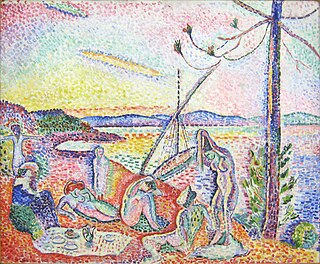
The Société des Artistes Indépendants or Salon des Indépendants was formed in Paris on 29 July 1884. The association began with the organization of massive exhibitions in Paris, choosing the slogan "sans jury ni récompense". Albert Dubois-Pillet, Odilon Redon, Georges Seurat and Paul Signac were among its founders. For the following three decades their annual exhibitions set the trends in art of the early 20th century, along with the Salon d'Automne. This is where artworks were often first displayed and widely discussed. World War I brought a closure to the salon, though the Artistes Indépendants remained active. Since 1920, the headquarters has been located in the vast basements of the Grand Palais.

Henri Victor Gabriel Le Fauconnier was a French Cubist painter born in Hesdin. Le Fauconnier was seen as one of the leading figures among the Montparnasse Cubists. At the 1911 Salon des Indépendants Le Fauconnier and colleagues Jean Metzinger, Albert Gleizes, Fernand Léger and Robert Delaunay caused a scandal with their Cubist paintings. He was in contacts with many European avant-garde artists such as Wassily Kandinsky, writing a theoretical text for the catalogue of the Neue Künstlervereinigung in Munich, of which he became a member. His paintings were exhibited in Moscow reproduced as examples of the latest art in Der Blaue Reiter Almanach.
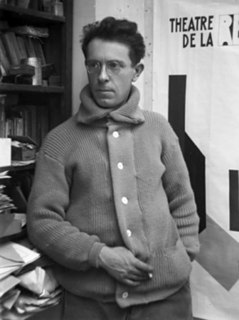
Joseph Csaky was a Hungarian avant-garde artist, sculptor, and graphic artist, best known for his early participation in the Cubist movement as a sculptor. Csaky was one of the first sculptors in Paris to apply the principles of pictorial Cubism to his art. A pioneer of modern sculpture, Csaky is among the most important sculptors of the early 20th century. He was an active member of the Section d'Or group between 1911 and 1914, and closely associated with Crystal Cubism, Purism, De Stijl, Abstract art, and Art Deco throughout the 1920s and 1930s.

Danseuse au café is a large oil painting created in 1912 by the French artist and theorist Jean Metzinger (1883–1956). The work was exhibited in Paris at the Salon d'Automne of 1912, entitled Danseuse. The Cubist contribution to the 1912 Salon d'Automne created a controversy in the Municipal Council of Paris, leading to a debate in the Chambre des Députés about the use of public funds to provide the venue for such 'barbaric' art. The Cubists were defended by the Socialist deputy, Marcel Sembat. This painting was realized as Albert Gleizes and Jean Metzinger, in preparation for the Salon de la Section d'Or, published a major defence of Cubism, resulting in the first theoretical essay on the new movement, Du "Cubisme". Danseuse au café was first reproduced in a photograph published in an article entitled Au Salon d'Automne "Les Indépendants" in the French newspaper Excelsior, 2 Octobre 1912. The painting is now located at the Albright-Knox Art Gallery, Buffalo New York.

Le Goûter, also known as Tea Time (Tea-Time), and Femme à la Cuillère is an oil painting created in 1911 by the French artist and theorist Jean Metzinger (1883–1956). It was exhibited in Paris at the Salon d'Automne of 1911, and the Salon de la Section d'Or, 1912.

Proto-Cubism is an intermediary transition phase in the history of art chronologically extending from 1906 to 1910. Evidence suggests that the production of proto-Cubist paintings resulted from a wide-ranging series of experiments, circumstances, influences and conditions, rather than from one isolated static event, trajectory, artist or discourse. With its roots stemming from at least the late 19th century this period can be characterized by a move towards the radical geometrization of form and a reduction or limitation of the color palette. It is essentially the first experimental and exploratory phase of an art movement that would become altogether more extreme, known from the spring of 1911 as Cubism.

Portrait of Jacques Nayral is a large oil painting created in 1911 by the French artist, theorist and writer Albert Gleizes (1881–1953). It was exhibited in Paris at the Salon d'Automne of 1911, the Salon de la Section d'Or, 1912, and reproduced in Du "Cubisme" written by Jean Metzinger and Albert Gleizes in 1912, the first and only manifesto on Cubism. Metzinger in 1911 described Gleizes' painting as 'a great portrait'. Portrait of Jacques Nayral, one of Gleizes' first major Cubist works, while still 'readable' in the figurative or representational sense, exemplifies the mobile, dynamic fragmentation of form characteristic of Cubism at the outset of 1911. Highly sophisticated in theory and in practice, this aspect of simultaneity would soon become identified with the practices of the Section d'Or. Here, Gleizes deploys these techniques in a radical, personal and coherent manner.

Man on a Balcony, is a large oil painting created in 1912 by the French artist, theorist and writer Albert Gleizes (1881–1953). The painting was exhibited in Paris at the Salon d'Automne of 1912. The Cubist contribution to the salon created a controversy in the French Parliament about the use of public funds to provide the venue for such 'barbaric art'. Gleizes was a founder of Cubism, and demonstrates the principles of the movement in this monumental painting with its projecting planes and fragmented lines. The large size of the painting reflects Gleizes's ambition to show it in the large annual salon exhibitions in Paris, where he was able with others of his entourage to bring Cubism to wider audiences.

Portrait de l'éditeur Eugène Figuière, also referred to as The Publisher Eugene Figuiere, is a painting created in 1913 by the artist, theorist and writer Albert Gleizes. This work was exhibited at the Salon d'Automne, 1913 and Moderni Umeni, 45th Exhibition of SVU Mánes in Prague 1914, and several major exhibitions the following years. Executed in a highly Cubist idiom, the work nevertheless retains recognizable elements relative to its subject matter. The painting, reproduced in Comœdia, 14 November 1913, represents Eugène Figuière. Head of his own publishing company, Figuière strove to be identified with every modern development. In 1912 he published the first and only manifesto on Cubism entitled Du "Cubisme", written by Albert Gleizes and Jean Metzinger. In 1913 Figuière published Les Peintres Cubistes, Méditations Esthétiques , by Guillaume Apollinaire. The painting, purchased directly from the artist in 1948, is in the permanent collection of the Musée des beaux-arts de Lyon, France.

La Femme aux Phlox, also known as Woman with Phlox or Woman with Flowers, is an oil painting created in 1910 by the French artist and theorist Albert Gleizes (1881–1953). The painting was exhibited in Room 41 at the Salon des Indépendants in the Spring of 1911 ; the exhibition that introduced Cubism as a group manifestation to the general public for the first time. The complex collection of geometric masses in restrained colors exhibited in Room 41 created a scandal from which Cubism spread throughout Paris, France, Europe and the rest of the world. It was from the preview of the works by Gleizes, Jean Metzinger, Henri Le Fauconnier, Robert Delaunay, and Fernand Léger at the 1911 Indépendants that the term 'Cubism' can be dated. La Femme aux Phlox was again exhibited the following year at the Salon de la Section d'Or, Galerie La Boétie, 1912. La Femme aux Phlox was reproduced in The Cubist Painters, Aesthetic Meditations by Guillaume Apollinaire, published in 1913. The same year, the painting was again revealed to the general public, this time in the United States, at the International Exhibition of Modern Art, New York, Chicago, and Boston. The work is now in the Museum of Fine Arts, Houston, Gift of the Esther Florence Whinery Goodrich Foundation in 1965.

Le Port, also known as The Harbor, The Port or simply Marine, is a painting by the French artist Jean Metzinger. The work was exhibited in the spring of 1912 at the Salon des Indépendants in Paris, and at the Salon de La Section d'Or, Galerie La Boétie, October 1912, Paris,. Le Port was reproduced a few months later in the first major text on Cubism entitled Du "Cubisme", written in 1912 by Jean Metzinger and Albert Gleizes, published by Eugène Figuière Editeurs the same year. The Harbor was subsequently reproduced in The Cubist Painters, Aesthetic Meditations , written by Guillaume Apollinaire, published by Figuière in 1913. At the Salon des Indépendants of 1912, Apollinaire had noticed the classical Ingresque qualities of Metzinger's Le Port, and suggested that it deserved to be hung in the Musée du Luxembourg's modern art collection. The dimensions and current whereabouts of Le Port are unknown.
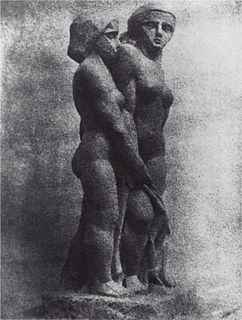
Groupe de femmes, also called Groupe de trois femmes, or Groupe de trois personnages, is an early Cubist sculpture created circa 1911 by the Hungarian avant-garde, sculptor, and graphic artist Joseph Csaky (1888–1971). This sculpture formerly known from a black and white photograph had been erroneously entitled Deux Femmes , as the image captured on an angle showed only two figures. An additional photograph found in the Csaky family archives shows a frontal view of the work, revealing three figures rather than two. Csaky's sculpture was exhibited at the 1912 Salon d'Automne, and the 1913 Salon des Indépendants, Paris. A photograph taken of Salle XI in sitiu at the 1912 Salon d'Automne and published in L'Illustration, 12 October 1912, p. 47, shows Groupe de femmes exhibited alongside the works of Jean Metzinger, František Kupka, Francis Picabia, Amedeo Modigliani and Henri Le Fauconnier.

The Société Normande de Peinture Moderne, also known as Société de Peinture Moderne, or alternatively, Normand Society of Modern Painting, was a collective of eminent painters, sculptors, poets, musicians and critics associated with Post-Impressionism, Fauvism, Cubism and Orphism. The Société Normande de la Peinture Moderne was a diverse collection of avant-garde artists; in part a subgrouping of the Cubist movement, evolving alongside the so-called Salon Cubist group, first independently then in tandem with the core group of Cubists that emerged at the Salon d'Automne and Salon des Indépendants between 1909 and 1911. Historically, the two groups merged in 1912, at the Section d'Or exhibition, but documents from the period prior to 1912 indicate the merging occurred earlier and in a more convoluted manner.
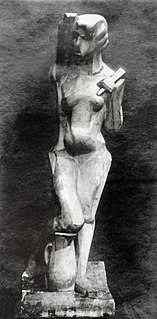
Danseuse, also known as Femme à l'éventail, or Femme à la cruche, is an early Cubist, Proto-Art Deco sculpture created in 1912 by the Hungarian avant-garde sculptor Joseph Csaky (1888–1971). This black and white photograph from the Csaky family archives shows a frontal view of the original 1912 plaster. Danseuse was exhibited in Paris at the 1912 Salon d'Automne, an exhibition that provoked a succès de scandale and resulted in a xenophobic and anti-modernist quarrel in the French National Assembly. The sculpture was then exhibited at the 1914 Salon des Indépendants entitled Femme à l'éventail ; and at Galerie Moos, Geneva, 1920, entitled Femme à la cruche.
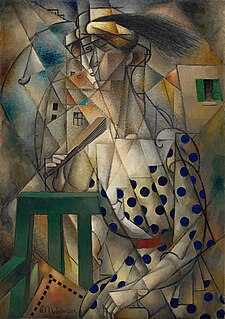
Femme à l'Éventail is an oil painting created in 1912 by the French artist and theorist Jean Metzinger (1883–1956). The painting was exhibited at the Salon d'Automne, 1912, Paris, and De Moderne Kunstkring, 1912, Amsterdam. It was also exhibited at the Musée Rath, Geneva, Exposition de cubistes français et d'un groupe d'artistes indépendants, 3–15 June 1913. A 1912 photograph of Femme à l'Éventail hanging on a wall inside the Salon Bourgeois was published in The Sun, 10 November 1912. The same photograph was reproduced in The Literary Digest, 30 November 1912.

Les Peintres Cubistes, Méditations Esthétiques, is a book written by Guillaume Apollinaire between 1905 and 1912, published in 1913. This was the third major text on Cubism; following Du "Cubisme" by Albert Gleizes and Jean Metzinger (1912); and André Salmon, Histoire anecdotique du cubisme (1912).





















